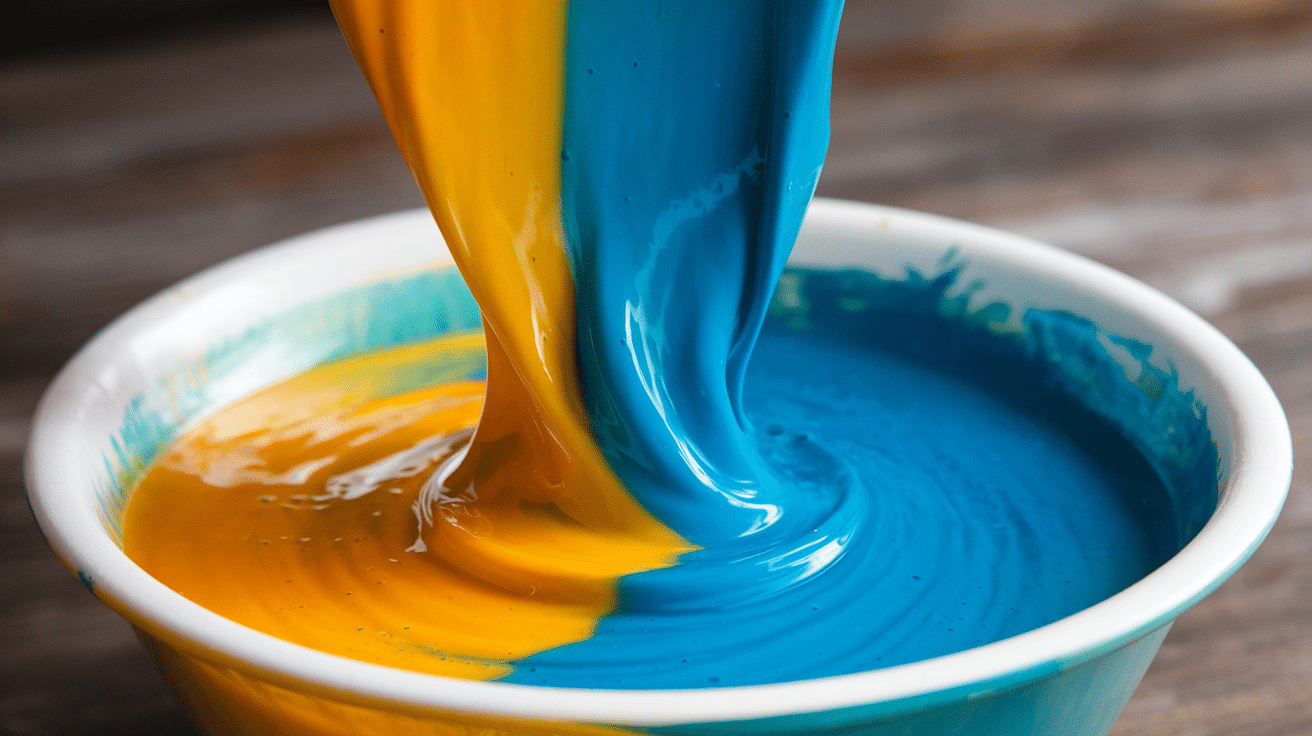Ever seen a substance that feels solid when you hit it but turns to liquid when you hold it? That’s oobleck, an interesting DIY science project that makes people of all ages stop and stare.
Most folks think cornstarch is the only way to make this odd goo, but they’re wrong. Several household items can create the same effect without a trip to the store. The best part? These alternatives often work just as well as the standard recipe.
This guide shows you exactly how to make oobleck without cornstarch using common household items. You’ll learn which ingredients work best and the right ratios to use.
Ready to mix up some magical goo that defies basic physics? Let’s get started with these simple methods anyone can try at home.
What is Oobleck?

Oobleck is a curious substance that falls between a solid and a liquid.
Named after the sticky green goo in Dr. Seuss’s book “Bartholomew and the Oobleck,” this material shows unusual properties that intrigue both children and adults.
When you press on it quickly or with force, it acts like a solid. But when you touch it gently or let it sit, it flows like a liquid. This strange behavior happens because oobleck is a “non-Newtonian fluid.”
Unlike water or oil that flow at a constant rate no matter how much force you apply, oobleck changes its thickness based on pressure. The standard recipe uses cornstarch and water, but many other common items can create this same weird effect without cornstarch.
Oobleck vs. Traditional Slime: Key Differences
While both oobleck and slime offer hands-on fun, they differ in several important ways. Here’s how these two popular science activities compare:
| Feature | Oobleck | Traditional Slime |
|---|---|---|
| Basic ingredients | Water and starch (or alternatives) | Glue and an activator |
| Texture | Firm when pressed, flows when relaxed | Stretchy and pliable at all times |
| Storage life | Hours to days | Weeks to months with proper storage |
| Cleanup | Easier, dissolves in water | More difficult, can stick to surfaces |
| Science concept | Non-Newtonian fluid physics | Polymer chemistry |
| Feel | Grainy, can feel dry when handled | Smooth and wet-feeling |
| Reaction to force | Becomes solid under pressure | Remains flexible regardless of force |
Both substances offer valuable learning experiences and sensory play, but oobleck provides a more dramatic demonstration of unusual physical properties that can be created with simpler ingredients.
Creative Recipes for Oobleck Without Cornstarch
Making oobleck doesn’t always require cornstarch. Here are five simple recipes using items you might already have at home that create the same interesting non-Newtonian fluid effect.
1. Baking Soda Oobleck

Ingredients required:
- 2 cups baking soda
- 1/2 cup water
- Food coloring (optional)
Instructions: Mix the baking soda in a large bowl. Add water slowly while stirring continuously. The mixture will feel dry at first. Keep adding small amounts of water until you reach the right consistency.
Test by tapping the surface – it should feel solid but your finger will sink in when resting on top.
If the mixture is too runny, add more baking soda. If it’s too firm, add tiny amounts of water. Add food coloring for a more fun appearance.
2. Potato Starch Oobleck

Ingredients required:
- 2 cups potato starch
- 1 cup water
- Food coloring (optional)
Instructions: Pour the potato starch into a mixing bowl. Add half the water and stir with a spoon. Continue adding water bit by bit while mixing until the substance feels like thick honey but hardens when you tap it.
The perfect consistency allows you to roll the mixture into a ball when moving quickly, but it melts through your fingers when you stop.
If you add too much water, simply mix in more potato starch. This recipe works well because potato starch has similar molecular properties to cornstarch, creating that perfect solid-to-liquid switching behavior.
3. Baby Powder Oobleck

Ingredients required:
- 2 cups baby powder (talc-free version)
- 1 cup water
- Food coloring (optional)
Instructions: Start by pouring the baby powder into a bowl. Add water slowly, about a tablespoon at a time, while mixing thoroughly. The mixture will gradually thicken. Keep adding water until the substance resists quick movements but flows slowly.
4. Tapioca Flour Oobleck

Ingredients required:
- 2 cups tapioca flour
- 3/4 cup water
- Food coloring (optional)
Instructions: Empty the tapioca flour into a large mixing container. Add water gradually while stirring with a wooden spoon. The mixture will resist at first, so be patient and keep mixing. Continue adding small amounts of water until the substance feels liquid when touched gently but offers resistance when struck.
Test by punching the surface – your hand should bounce off rather than sink in. If it splashes, add more tapioca flour.
This version tends to be slightly stickier than cornstarch oobleck but demonstrates the same interesting physical properties.
5. Arrowroot Powder Oobleck

Ingredients required:
- 2 cups arrowroot powder
- 1 cup water
- Food coloring (optional)
Instructions: Place arrowroot powder in a bowl. Add water in small amounts, mixing thoroughly between additions. The key is finding the right balance – too little water makes a crumbly mix, too much creates a runny liquid. When properly mixed, you can roll it between your palms to form a ball, but it will flow like a liquid when you stop applying pressure.
Arrowroot powder creates a particularly smooth oobleck that’s less likely to irritate sensitive skin, making it good for younger children’s science play. The white color also takes food coloring well for lively results.
Each of these alternatives creates the intriguing non-Newtonian fluid effect without cornstarch, showing how different starches and powders can produce similar scientific results.
Fun Oobleck Activities for Hands-On Learning

Oobleck isn’t just fun to make, it’s also a great tool for hands-on learning. Here are four simple activities that teach science concepts while keeping kids engaged and excited:
1. Dancing Oobleck Sound Experiment
Watch as oobleck jumps and dances in response to sound vibrations.
- What you need: A shallow pan, oobleck mixture, plastic wrap, a speaker, and music with strong bass.
- How to play: Pour oobleck into the pan and cover it with plastic wrap to prevent splashes. Place the pan on a speaker and play music with heavy bass. Watch the oobleck form peaks and valleys as it reacts to the sound vibrations, creating patterns that change with different frequencies.
2. Oobleck Treasure Hunt
Find hidden objects in this messy, tactile challenge.
- What you need: A large container, oobleck mixture, small waterproof toys or coins.
- How to play: Mix a large batch of oobleck in a container. Hide small toys or coins inside the mixture. Players must try to find and retrieve the items without using tools, just their hands. The trick is to move slowly when reaching in but grab items quickly.
3. Oobleck Monster Attack
Create a fun narrative-based science play scenario.
- What you need: Oobleck mixture, toy figurines, a shallow tray or cookie sheet.
- How to play: Pour oobleck onto the tray. Set up toy figures at one end. Tell a story about monsters stuck in quicksand as children try to “save” the toys. They’ll learn that quick, forceful movements work better than slow pulls, teaching physics concepts through play.
4. Oobleck Art Prints
Make colorful temporary prints using this unique substance.
- What you need: Colored oobleck mixtures, thick paper, various textured objects like cookie cutters or combs.
- How to play: Create several batches of oobleck in different colors. Press textured objects into the oobleck, then carefully press paper on top to create prints. The prints will dry temporarily before the colors run together, creating a lesson in both art and temporary states of matter.
These activities modify simple oobleck into educational opportunities that look into physics, problem-solving, storytelling, and artistic expression.
Each one offers a different way to engage with this intriguing substance while learning important scientific concepts.
Wrapping It Up
Oobleck offers a perfect blend of science and play without the need for cornstarch.
The five alternative recipes shared here work just as well for creating this strange substance that acts both solid and liquid. These recipes let anyone make oobleck with common household items, proving that fun science activities don’t require special ingredients.
From sound experiments to monster attacks, oobleck provides countless ways to learn about non-Newtonian fluids while having a great time. Children and adults alike can enjoy the unusual properties of this substance that flows like liquid but hardens with pressure.
Ready to try making oobleck at home? Share your experiences in the comments section below! Which recipe worked best for you?
Frequently Asked Questions
When Is the Best Time to Make Oobleck?
Anytime works, but rainy days or school holidays are perfect. Make it outdoors in summer to avoid indoor mess or as a weekend science activity.
How Long Does Oobleck Last?
Without preservatives, homemade oobleck lasts 2-3 days in an airtight container in the fridge. It may dry out or start to smell after that.
How Does Oobleck Work Without Cornstarch?
Alternative starches and powders work because they have similar molecular structures that create the same resistance to pressure while flowing at rest.
How Does Oobleck Without Cornstarch Compare to Traditional?
Alternative ooblecks feel slightly different but show the same non-Newtonian properties. Some might be smoother, stickier, or have pleasant scents depending on ingredients used.




